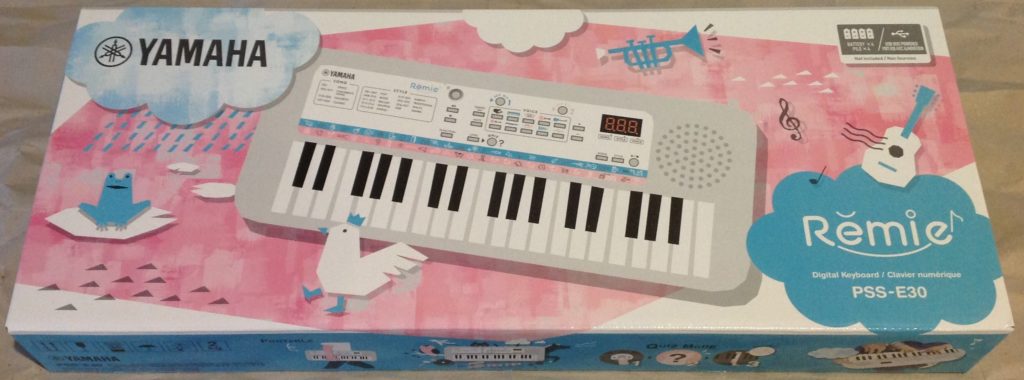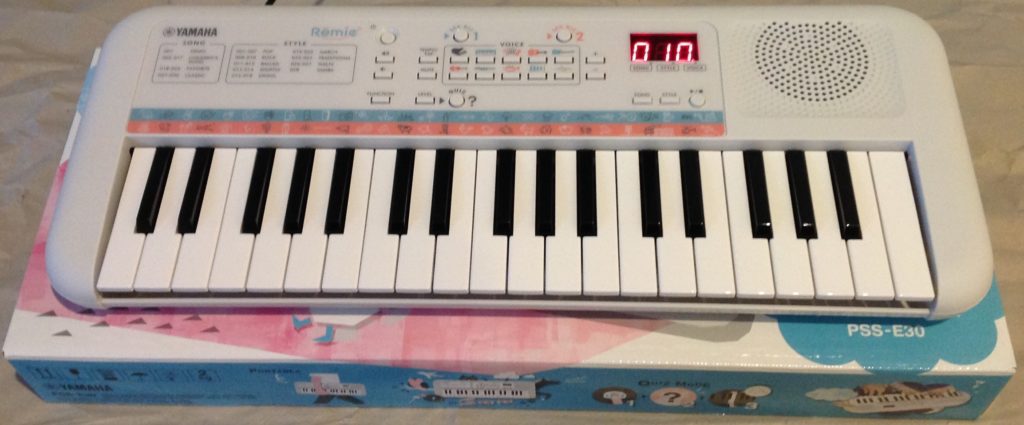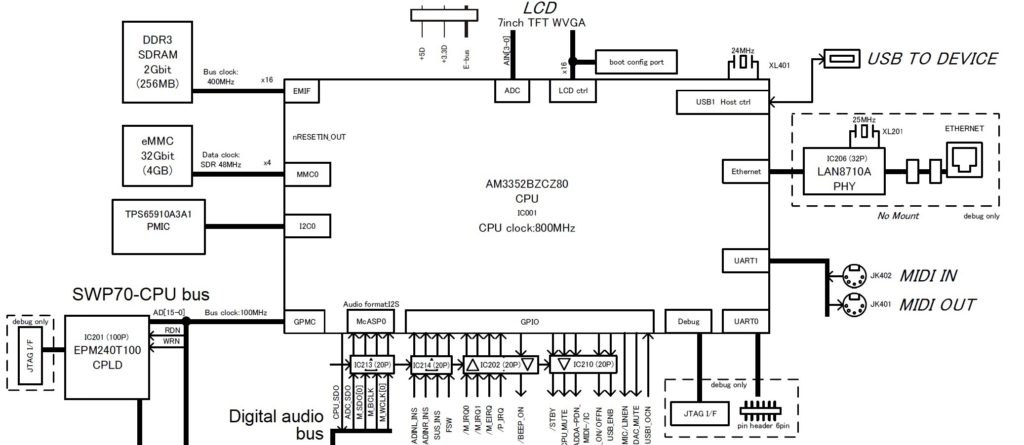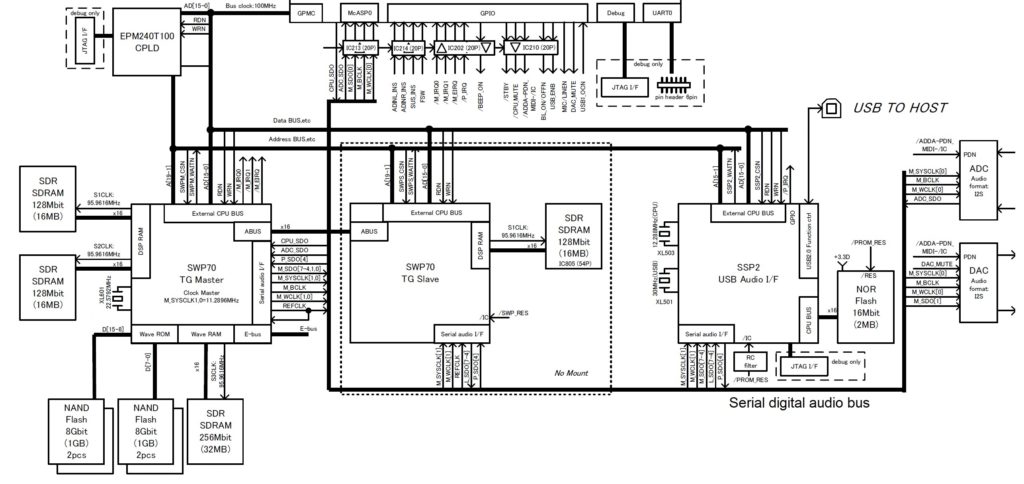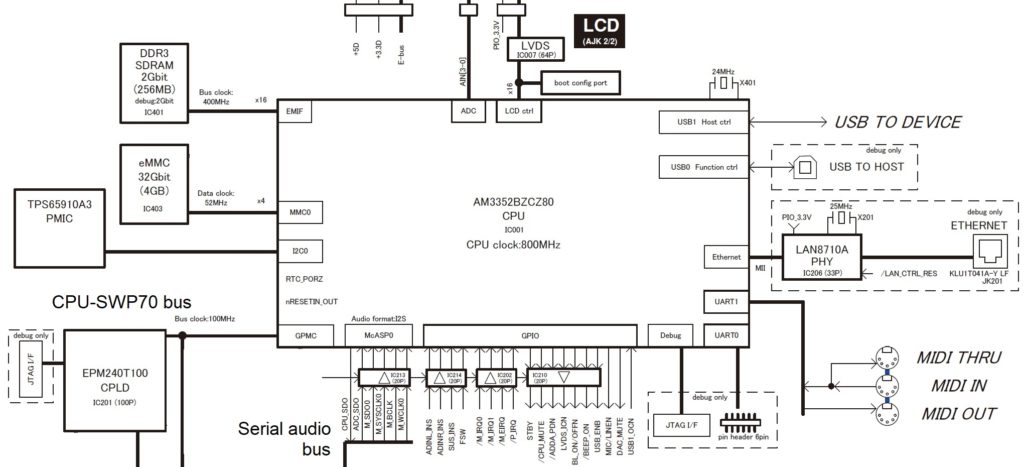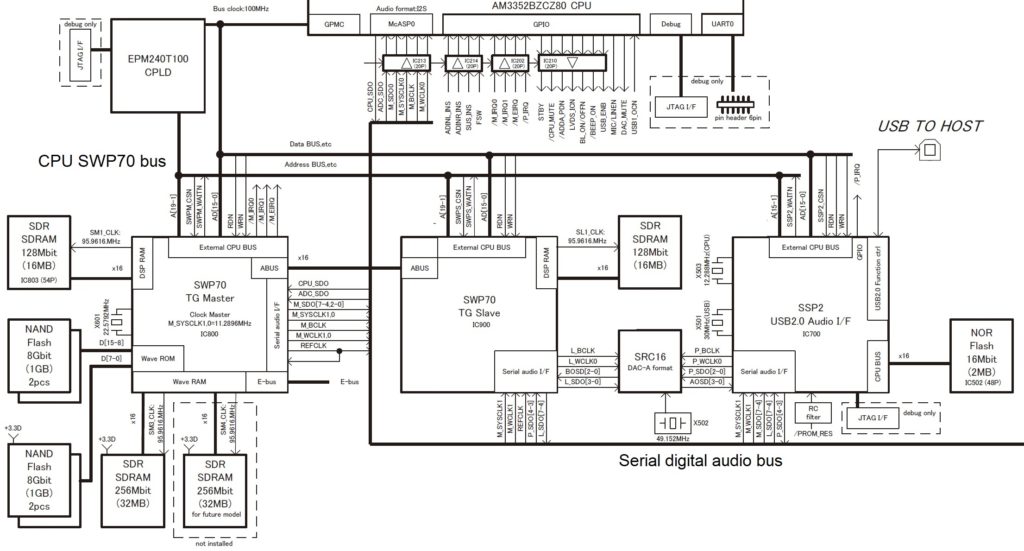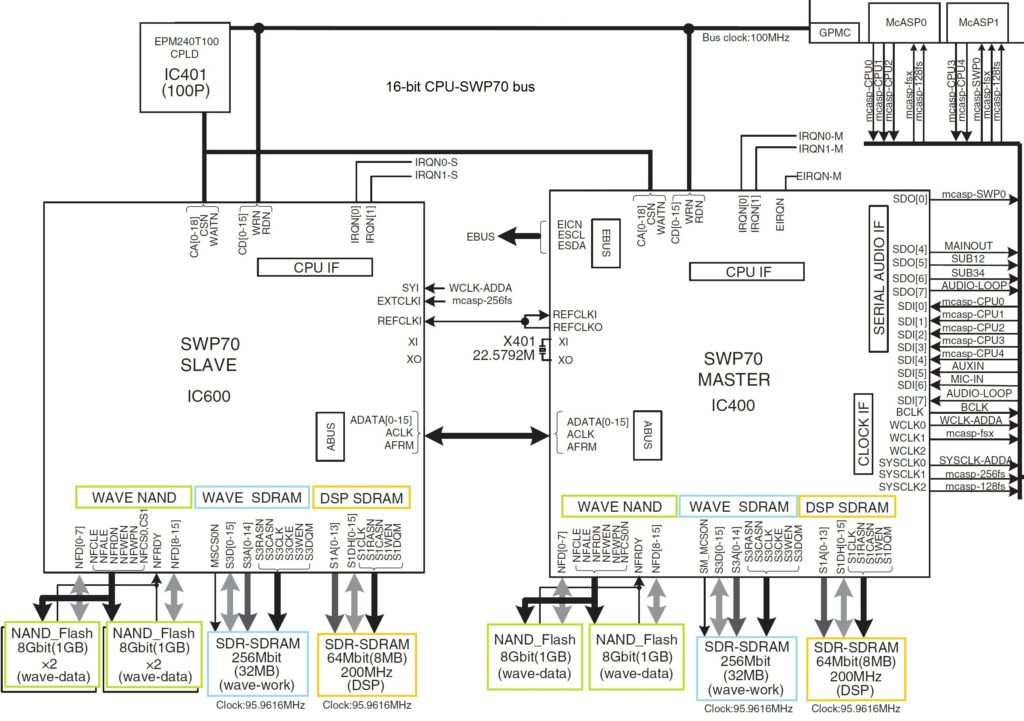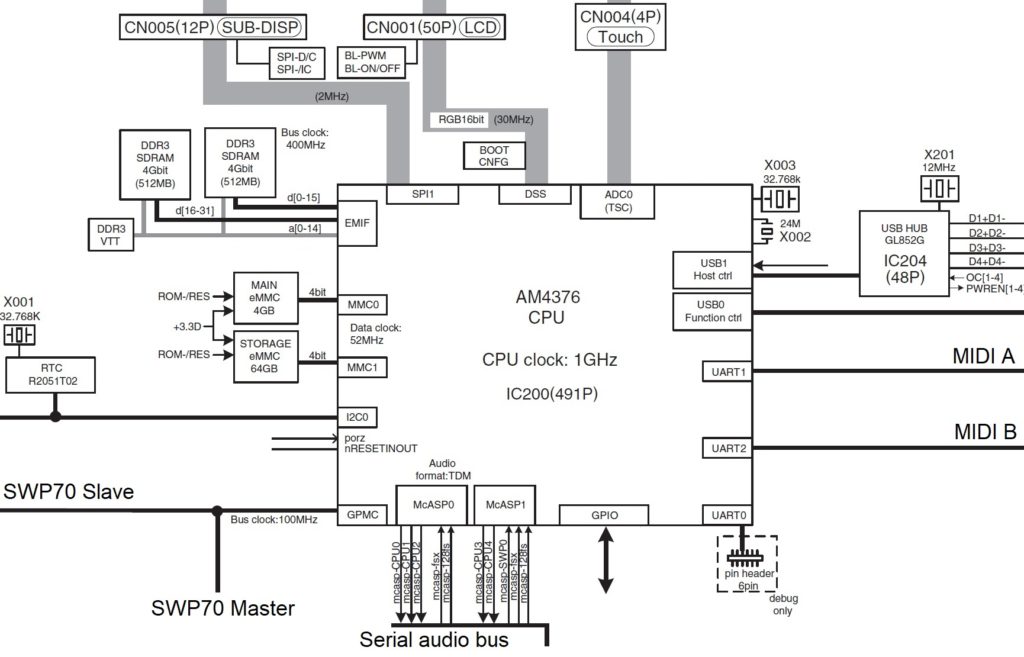Now let’s take a first look at Yamaha PSS-E30 Remie inside.
My Remie is a seasoned world traveller. It was designed in Japan, made in India, distributed by Rellingen, Germany, sold by Amazon UK and played in Washington state, USA. Physics and electrons are indeed universal.
The PSS-E30, PSS-F30 and PSS-A50 are essentially the same physical product. They are part of a family like Reface. The Reface family, BTW, is two pairs of fraternal twins: YC/CP and CS/DX. The PSS family are fraternal triplets and share the same printed circuit board (PCB). In fact, the PCB has three little check boxes. A mark in a check box denotes the specific product personality.
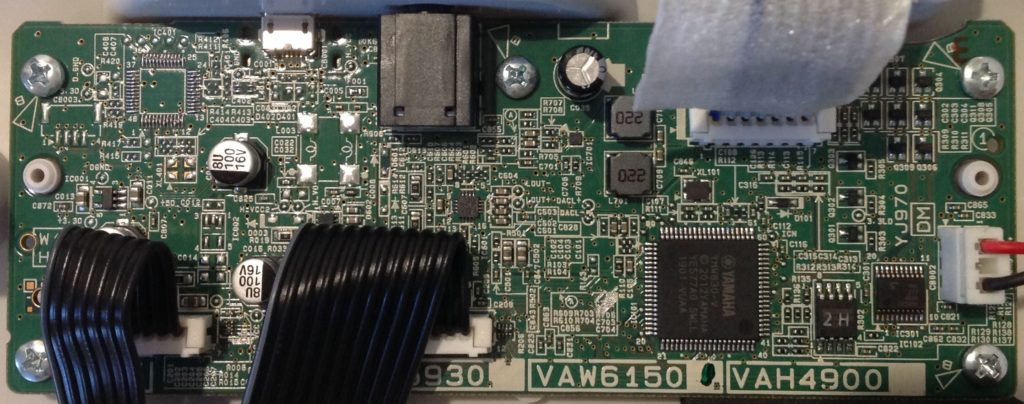
Product personality is determined by four things: front panel graphics, software, content (voices, styles, etc.) and USB interface.
Line up the three PSS keyboards and you see that they all have the same panel layout. The buttons are all in the same physical place. Everything else that is external is just skin (case color and stick on panel graphics). The panel connections to the digital logic board (DM) are the same in all three products.
Next up, each member of the family has different code and content. The software and content are stored in a Winbond 2MByte serial ROM. The main CPU (SWLL) reads the binary code and waveforms from ROM at boot time. The ROM components are stamped with a product specific code: “2H” for Remie and “2I” for the PSS-A50.
The 2MByte ROM holds both code and waveforms. The small ROM harkens back to the day of the Yamaha QY-70 when XG voices and drum kits fit into 4MBytes. Given the small ROM, one shouldn’t expect super high voice quality in any of the models.
The SWLL is reminiscent of the YMW-820 NSX-1 integrated circuit. The NSX-1 is the engine behind Pocket Miku and eVocaloid.
Finally, the PSS-A50 is the only sibling with an active USB interface. Remie has an unpopulated IC site as you can see in the upper left corner of its PCB. This site is populated with a USB chip in the A50. Without the chip, Yamaha can build and sell Remie at a lower cost than the A50. Even if one carefully soldered the correct USB IC into the unpopulated site in Remie, I doubt if Remie’s software has the code to recognize it.
The PSS-F30 is a shrunken PSR-F50. For the rest of this discussion, I’m using the Yamaha PSR-F50 Service Manual as my guide to the electronics. As to the keybed, I’m using the Reface YC Service Manual.
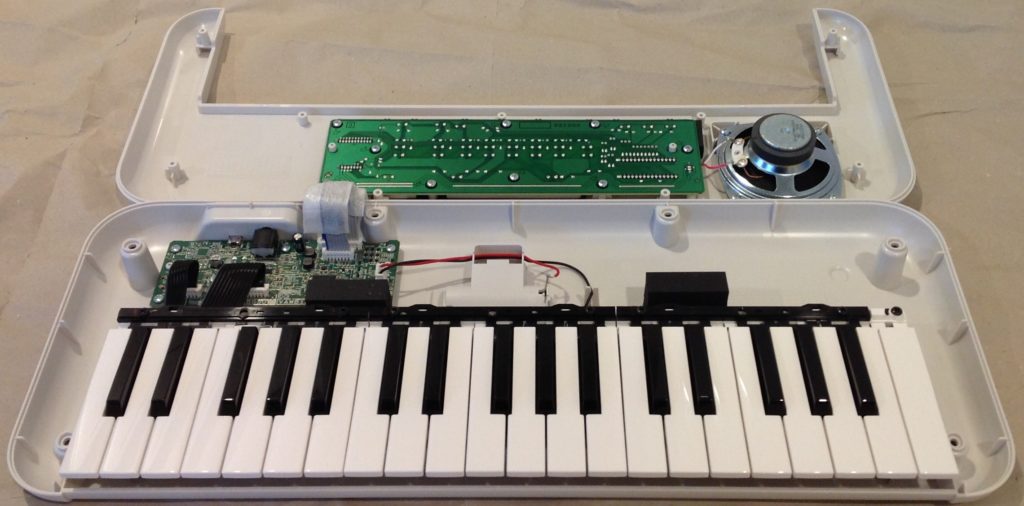
Inside, each member of the PSS family consists of three circuit boards: the main logic board (DM), the front panel board and the keybed. The front panel board and keybed are each a switch matrix. The CPU scans both the front panel and keybed separately. It scans each board by asserting a switch group select signal and then reading the current state of each switch in the group.
There are twelve switches in a keybed group, two switches per key. The switch contacts are at two different heights and close at two different times when struck. The CPU measures the closure time between the first contact and the second conent in order to sense key velocity.
The panel PCB and the keybed PCB are each joined to the digital logic board by short ribbon cables. The loudspeaker signals hitch a ride through the front panel ribbon cable.
The main CPU and tone generator is a Yamaha proprietary integrated circuit — the YMW830-V or “SWLL”. The SWLL is the ultra-small brother to the SWL01. The chip is housed in an 80 pin surface mount quad pack which is only 1.3cm on a side. That’s tiny. The entire PCB is a tidy 13.5cm by 4.5cm.
The SWLL is a true system on a chip (SOC) containing the CPU, RAM, tone generation circuitry, UART, ADCs and DACs. Amazing. The chip inside is small, too, and Yamaha can print these like postage stamps in large volume. Everything about the SWLL screams “low cost”.
Using the PSR-F50 Service Manual, here is the SWLL pin-out:
1 DACLPP Left channel DAC output (positive)
2 DACLMM Left channel DAC output (minus)
3 DAC_VDD DAC Vdd
4 DAC_VSS DAC Vss
5 DACRMM Right channel DAC output (minus)
6 DACRPP Right channel DAC output (positive)
7 VSS Vss
8 KYN11 Key sense (input)
9 KYN12 Key sense
10 KYN13 Key sense
11 KYN14 Key sense
12 KYN15 Key sense
13 KYN16 Key sense
14 KYB1 Keyboard key group select (output)
15 KYB2 Keyboard key group select
16 KYB3 Keyboard key group select
17 KYB4 Keyboard key group select
18 KYB5 Keyboard key group select
19 KYB6 Keyboard key group select
20 KYB7 Keyboard key group select
21 KYB8 Keyboard key group select
22 KYB9 Keyboard key group select
23 KYB10 Keyboard key group select
24 KYB11 Keyboard key group select
25 IOVDD
26 VSS
27 LDOTSTO
28 KYN21 Key sense (input)
29 KYN22 Key sense
30 KYN23 Key sense
31 KYN24 Key sense
32 KYN25 Key sense
33 KYN26 Key sense
34 SWIN0 Panel scan input
35 SWIN1 Panel scan input
36 SWIN2 Panel scan input
37 SWIN3 Panel scan input
38 VSS
39 SDQ2 Serial ROM WP# (DQ2)
40 SDO Serial ROM DO (DQ1)
41 SCSN Serial ROM chip select (CS#)
42 IOVDD
43 SDQ3 Serial ROM NC (DQ3)
44 SCLK Serial ROM clock (CLK)
45 SDI Serial ROM DI (DQ0)
46 VSS
47 PORTB0 PSW0
48 PORTB1 (7seg_e0)
49 PORTB2 (7seg_e1)
50 PORTB3 (7seg_e2)
51 PORTB4 (7seg_lat)
52 PORTE0 /PSWI
53 PORTC0 (Sustain input)
54 TXD UART transmit data (output)
55 RXD UART receive data (input)
56 PLLBP
57 TEST
58 LDOTST
59 IC_ (Voltage detector)
60 VSS
61 ADC_VDD (+3.3V)
62 ADC_VSS (Ground)
63 AN0 Analog input
64 AN1 Analog input (battery check)
65 VSS
66 PLLVSS
67 PLLVDD
68 LDOC
69 LDOVDD
70 LDOVSS
71 VSS
72 XI Crystal input
73 XO Crystal output
74 VSS
75 IOVDD
76 TDO Test data out
77 TCK Test clock
78 TMS
79 TDI Test data in
80 TRST_ Test reset
I determined pin function by tracing signals in the PSR-F50 Service Manual. Yamaha may have changed things a bit in Remie and A50. I have not determined how the USB interface is connected to SWLL in the A50 nor have I even identified the component.
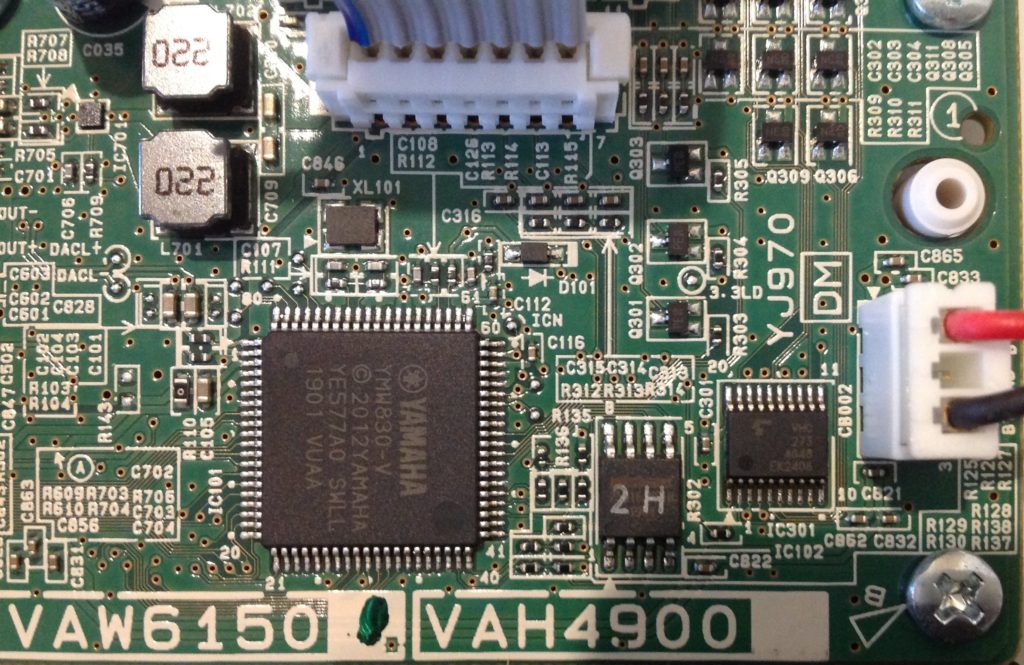
For the PSR-F50, the SWLL internal clock is 33.8688MHz and the master clock is 67.7376MHz. The clocks are generated from a 16.9344MHz crystal. All clocks are a multiple of 44,100Hz, the sample frequency. I can’t read the marking on Remie’s crystal, but there isn’t any reason to believe that it differs from F50.
The three digit LED display is both retro and cheap. Remie has the same eleven transistors driving the time-multiplexed seven segment display.
- Under software control, transistors Q301 to Q303 (7seg_e0 to 7seg_e2) select one of the three digits.
- Transistors Q304 to Q311 drive the individual segments.
Segment status is latched into an eight flip-flop SN74LV273 from the SWL KYB1 to KYB8 pins. The latch clock is produced by SWLL pin PORTB4 (7seg_lat). Note that the KYB pins do double duty as inputs from the keybed.
Whew! That leaves us deep in the weeds! Next time, I’ll outline a few ways to mod the new PSS keyboards.
Update: Compare Remie against my Yamaha PSS-A50 teardown.
Copyright © 2019 Paul J. Drongowski

